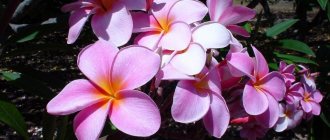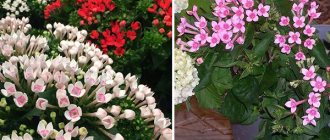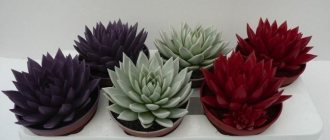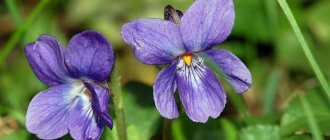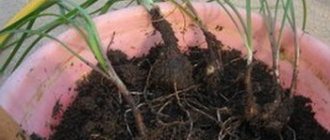The indoor flower Lantana is very common these days. It is actively grown in the garden, in tubs, and in apartments.
Author of the article
Anna Dmitrieva
Gardener with 15 years of experience.
Description of the bush
- The flowers of the plant converge into rounded corymbose-shaped inflorescences. The main advantage is the very long and abundant flowering process.
- At the same time, growing lantana is not difficult, the plant is unpretentious and has a compact shape. It is one of the 10 best crops for tub cultivation in the south of our country.
- Despite the advantages, there are nuances that definitely need to be paid attention to. Hybrid lantana represents selection forms. Such species are the most common in the gardening community. They have good decorative properties.
A little from the botany course
The homeland of this exotic flower is considered to be South and Central America. However, certain species of perennial plants are often found in Africa and Southeast Asia. In its natural habitat it grows quite quickly, so in some areas it is considered a weed. According to some reports, the Verbenov family has about 150-170 species. Only lantana Kamara (Spiky) is grown indoors. It was on the basis of this species and several others that breeders developed many magnificent varieties of crops.
Main characteristicsb plants:
- refers to shrubs or subshrubs;
- has a specific smell, in which notes of onion and mint with lemon can be discerned;
- erect branches of a greenish-gray hue (sometimes covered with frequent thorns);
- smooth/rough leaves with jagged edges are arranged oppositely (can grow in a spiral);
- small cup-shaped flowers are collected in spherical or corymbose inflorescences, the petals of which gradually change their color.
The root system of representatives of the Verbenov family is very well developed. When grown outdoors, the roots go deep into the soil. For this reason, when planting in tubs or pots, the crop requires frequent transplants.
To understand how to organize lantana care at home, you need to know some of the features of how the crop grows in the wild. Its tropical origin is the main clue to unraveling this secret.
For those latitudes it is typical:
- high humidity;
- warm climate;
- good lighting.
All these points must be taken into account when growing a flower. The flowering period of the bush occurs at the beginning of May and continues until October. With good lighting, the crop will delight with its special decorativeness throughout the year, but with a short break.
Species cultivation
Lantana camara flower
It is an evergreen shrub plant. The length and width of this specimen range from 1 to 2 meters. At home, such lantana creates small compact variations up to half a meter in height.
Stems are straight and branched, tetrahedral. Sometimes they have spines on their body. The leaves have an oval oblong shape. The surface is embossed and wrinkled. The length does not exceed 10 centimeters. They have the aroma of warm grass.
The flowers are small. They are collected in inflorescences about 5 cm in size. The process occurs from late spring to mid-autumn.
Interesting blue-black fruits and berries with a bluish bloom ripen.
French breeders have done a good job of developing beautiful varieties. They were able to move away from the original multi-colored varieties and create monochromatic varieties. The palette has become brighter and more varied.
Samantha and White Drift
Thus, lovers of monotonous flowering actively use the varieties “Samantha” and “White Dwarf” in their cultivation. The first has a bright yellow color, the second is white.
Aloha
In container growing, the “Aloha” variety has become one of the most popular. It has descending soft shoots. The leaves are bright and the flowers are pale yellow.
Goldsonne
The “Goldsonne” variety has proven itself in the field of hanging cultivation. It has bright yellow flowers and spreading shoots.
Sterile varieties of the plant have also been developed. They bloom beautifully and abundantly, but fruit set does not occur. These include the following: “New Gold” (it has bright yellow flowers), “Miss Huff” (coral, yellow and orange inflorescences), “Silver Mound” (cream with a yellowish center). These species perfectly decorate the garden plot in the summer.
Varieties of dwarf sizes are in particular demand.
Caring for lantana camara at home
Caring for this unique herbaceous plant is not at all difficult, but care procedures must be regular. Standard watering, fertilizing, and other care items in combination with mandatory hygienic procedures - that’s all the plant needs.
Watering and air humidity
The main task when caring for lantanas is to prevent the substrate from completely drying out. This plant does not tolerate dampness, but if you skip watering and allow the earthen clod to dry out, lantana will begin to shed its lower leaves.
Water the plant, allowing the upper part of the substrate to dry, but trying to maintain stable humidity. The plant is not afraid of heavy watering, but it is better to drain the water from the trays 20-30 minutes after watering.
During wintering, watering of lantana camara is reduced several times, trying to maintain very light soil moisture. If plants overwinter in cool conditions, you need to be very careful with watering, and when dropping leaves in warmth, they are carried out only to maintain the viability of the roots. The water should be soft and warm.
Outside the flowering period, lantanas can be sprayed, but they also tolerate dry air. But it is imperative to keep the leaves clean by carefully removing dust from them.
Top dressing and fertilizer composition
Despite its rapid growth and fairly rapid depletion of the soil, lantana does not tolerate too much fertilizing. Even if you use the standard strategy for garden tubs or beautifully flowering pots, there is a risk of creating the effect of excessive fertilizing and stimulating the growth of leaves to the detriment of flowering.
For lantana, fertilizers are applied regularly, from March until the end of flowering, with the usual frequency of once every 2 weeks, but the concentration of fertilizing is reduced by 2 times compared to the manufacturer’s instructions. It is undesirable to make fertilizing common but rare, because this way the plant will grow in less stable conditions with differences in soil nutritional values.
For lantana, despite its status as a flowering crop, fertilizers specifically formulated to stimulate flowering are not suitable. This crop prefers complex balanced fertilizers with equal content of all three macroelements. Only during the period of preparation for flowering at the budding stage can potassium-phosphorus fertilizers be applied.
Lantana camara Lucky Sunrise. © bakker
Pruning and shaping lantana camara
Lantana camara blooms only on young, one-year-old shoots that have not yet begun to woody, and pruning and regular pruning only stimulate more abundant flowering.
This is a unique plant that is cut regularly in the summer, at least 2-3 times, stimulating both tillering and flowering. For lantana, pruning is carried out at the end of winter or before transplanting, repeating regulatory cuts or slightly shortening the shoots up to 4-5 times per season.
Formation during the first two years is critical for all lantana species - when the plant is given the shape of a tree and shrub, which is only maintained from the third year. Lantana shoots can be shortened according to the desired contour or size, leaving at least 1-2 pairs of leaves on the branches. Lantana tolerates both strong cutting and light pinching of the tops equally well.
If lantanas overwinter in warm conditions or begin to lose their decorative appearance and require rejuvenation, they are radically pruned, leaving only the lower buds on the branches, and where the old shoots have become very elongated, cutting off lignified shoots. Such lantanas require mandatory transplantation.
Lantanas, despite their rapid flowering and seemingly difficult to restrain growth, are one of the best candidates for indoor topiary. The crown of the plant can be neatly and carefully trimmed into a certain shape, most often emphasizing the natural density and spherical silhouettes.
Neat and elegant balls on bollards can become a small miracle in containers. Especially often, those lantanas that are grown as indoor gardens or gardens with wintering indoors are pruned according to a strict canon.
Lantana can be grown as a standard plant, and the “leg” is amazingly easy to form. To turn rainbow nettle into a tree, it is enough not to touch the central shoot until it grows to a height of more than 60 cm, and remove only all the side branches, leaving the base of the shoot “bare” to a height of 30-50 cm. Above 50 cm, the “trunk” » lantanas should not be driven out; longer stems will not allow the plant to remain stable.
Transplantation, containers and substrate
Lantana camara grows very quickly and just as quickly takes over the available soil. The rapid development of both the aboveground part and the rhizome requires regular replanting. Despite the fact that, like any other tub, it is better to replant lantana as needed, it is usually replanted annually. Only plants in a neglected state or formed into strict trunks do not have time to master the entire substrate in a year.
Usually, due to lack of space for roots to develop and depletion of soil, lantana camaras stop blooming. If replanting is not carried out, the plant must still replace the top layer of soil with a fresh nutrient substrate.
For lantana, be sure to select large, spacious, deep containers with good drainage holes.
For this crop, loose and nutritious soil mixtures are preferred, but not overly fertile soils. Lantana depletes any substrate quite quickly, but excessive fertility impairs flowering and stimulates rapid growth, but choosing an average or low-nutrient substrate allows you to better control the plant and enhance flowering.
For lantana camara, simple soil mixtures of leaf soil with sand in equal parts or substrates consisting of turf, leaf soil, peat and sand with a predominance of turf soil are suitable. When choosing purchased substrates, use soil mixtures with a complex composition and be sure to add an additional portion of loosening components.
Transplantation is usually carried out in the form of transshipment with shortening of the roots after reaching the maximum volumes of the containers. A high layer of drainage is laid at the bottom of the containers.
The best propagation method for lantana camara is cuttings. © bakker
Lantana: care and cultivation features
The nuances of keeping the plant depend on the method used: in an apartment, in a country house or in a tub culture.
Ground and location
For an apartment flower, the soil should consist of equal parts of turf soil, sand and humus. The plant loves active watering during the period of active growth. But it is important to avoid excess moisture, as it is no less destructive than drought.
It is best to place it on windows facing southeast and southwest. In summer, the light should be diffused. But the sun is a prerequisite for flowering.
Humidity and temperature
High humidity combined with high air temperature is detrimental to the flower. To achieve good branching, a lush crown, and the tips of the shoots should be pinched regularly. Lantana survives pruning well. Therefore, tall shoots must be shortened in time.
Once every 15 days it is necessary to provide complementary feeding with nutritious mineral preparations.
How to care:
- If the pot becomes small, then you should transplant it using the transfer method into a larger container. The month of July is best suited for these purposes. Replanting will ensure better flowering.
- In winter there comes a time of rest, which is important to organize correctly. Lantana should be placed in a bright room with a temperature of 12-14 degrees.
- Watering becomes less frequent. But it is strictly forbidden to overdry the soil. If the foliage has completely fallen, then the temperature should be maintained at about 6-8 degrees Celsius.
- In the spring, weak shoots are pruned and pinched to form a lantanta shape. Propagation by cuttings can be done just from the resulting branches.
Pests
When a whitefly pest appears on a flower, you need to wipe all the leaves on both sides with a damp cloth every day for 14 days. If there are a lot of insects, then the plant is sprayed with a preparation against cockroaches and placed in a bag that is tied.
The flower moves for a day to an open balcony or loggia in partial shade. Then, it is rinsed under a fresh shower.
Spraying
It is also advisable to periodically spray with water from a spray bottle. Although lantana tolerates dry conditions well, lack of moisture can cause spider mites or scale insects.
Water should be used soft, at room temperature. It is advisable that it does not fall on the inflorescences to prevent the formation of fungi.
Previously, we told you how to care for blechnum fern.
Contents using the tub method
Care is carried out similarly to indoor culture. The only difference is that the container with lantana gradually begins to be hardened and taken outside in the spring. But these actions should be carried out only when there is no longer any risk of frost.
Before the autumn cold snap, the flower is cut short and placed in a cool greenhouse with a temperature of about 7-9 degrees Celsius. Watering is rare.
Diseases
If the lantana in the tub is attacked by a whitefly, the plant is treated with Fitoverm according to the instructions. Particular attention should be paid to the inside of the leaves. Be sure to perform the procedure away from other plants, for example, in the backyard.
Transfer
Lantana is a fast-growing plant that requires replanting and transshipment. It's good to do this in the spring. If the plant is not replanted, it may refuse to bloom.
When transshipping:
- remove 2-3 mm of roots with a clean sharp knife,
- The bottom of the pot is lined with a drainage layer at least 4 cm thick,
- watered
- put in small partial shade for several days.
The flower consumes a lot of nutrients; when replanting is impossible, the top 5-7 cm of soil is replaced.
Lantana does not like stagnant humidity, so the substrate for the flower should easily allow air and water to pass through.
Possible options:
- humus, turf soil, sand - 2:1:1,
- ready soil for flowering indoor plants.
Growing in open ground
Keeping lantana in the garden in open ground is permissible in southern lands.
The care process should consist of the following procedures:
- In spring, the soil is dug up and loosened;
- Regular watering is organized;
- The earth is mulched with a natural substrate;
- In mid-spring, early summer and autumn, fertilizing is carried out;
- During growth, pruning and pinching are performed to form the required contour;
- After autumn frosts, pruning is carried out to create a “short stump”;
- For winter, cover with a small layer of mulch.
Diseases and pests
Due to high soil moisture, the plant is susceptible to various fungal diseases, the symptoms of which are spotting and the appearance of a reddish coating.
Some varieties may be susceptible to aphids and mealybugs, against which special agents should be used. Whiteflies can suck the juice from lantana leaves. Use an insecticide against such pests.
Flower propagation
You can grow lantana from seeds. They are pre-soaked in water at room temperature. After soaking for 24 hours, they are planted in a container. You need to wait for the emergence of seedlings from one to three months. In this case, it is necessary to maintain a temperature of 9-25 degrees Celsius.
Reproduction at home, which is possible using cuttings, easily takes root. Reception of shoots is carried out in March or summer. The apical branches are most suitable. Their trunk should be half woody. Length about 10 centimeters.
For planting, loose, moist soil made of sand and peat in equal proportions is suitable. The temperature should be maintained at around 20 degrees Celsius. The approximate rooting period is 3 weeks.
Humidity and watering conditions
This shrub is classified as moisture-loving. That is why it must be sprayed periodically using a special device. However, place the pot with the plant in a saucer of water, otherwise the rhizome may begin to rot, which will have a detrimental effect on the plant.
In summer, watering should be carried out regularly, so the soil should not be allowed to dry out under any circumstances. The soil should almost always be moist, but not wet. In winter, the frequency of watering should be reduced, but the soil moisture should be maintained at the same level.
Interesting Facts
- The leaves of the flower have an ambiguous aroma. Some people find it very unpleasant, reminiscent of the smell of cat urine. And some people fill pillows with them and use them as flavoring agents.
- The flowering of one bud lasts no more than three days.
- Unripe fruits are very toxic and dangerous for animals and humans.
- During the process, the color of the rubble changes from white to orange or red.
- Used for medicinal purposes. Helps with dermatitis, wounds and bites. For rheumatism and colds, a decoction of lantana is used.
- In Australia it is considered one of the most formidable and difficult to remove weeds.
- In open ground in southern territories it manifests itself very aggressively, displacing other plants. In India they even call it the “curse of the planters.”
- The plant is very beautiful and quite unpretentious. Achieving optimal conditions is not difficult. And abundant flowering will always please.
Varieties and varieties
Prickly lantana has spherical inflorescences that periodically change color. Most often, the color ranges from yellow, orange to red and pink.
Lyubava is a variety that reaches a height of one and a half meters. It has dense gray-green leaves and miniature flowers in fiery shades. Autumn is the most suitable time for flowering of lubava.
Montevideo lantana is perhaps the most exotic plant variety. It has flexible hanging stems, so it is most often placed in pots in the form of baskets. The inflorescences most often have a purple tint.
Lantana diseases
With high immunity, under unfavorable conditions, the plant can be affected by various diseases:
- Leaf rust
. From cold and dampness. Characterized by yellowish-orange spots. Therapy - spraying with a 1% Baktofit solution. - Root rot
. The result of stagnation of water in the roots. Appears as black spots on shoots and leaves. Treatment is soaking in a solution of a fungicide, for example, Trichodermin or Fitolavina. - Gray rot
. Lantana in a pot often develops beige-colored spots on the foliage. For treatment, the affected areas are removed, and then they are sprayed with the following drugs: “Chorusom”, “Zinebom”. - Brown spot
. Spots with a light olive color. Treatment is the use of Vectra or Fitosporin.
Types popular among amateur gardeners
Of the many species of lantana, only a few have adapted to home conditions. Most of the plants found in the apartments of amateur gardeners are selection hybrids, the “parent” of which is Lantana spinosa. Many of them have larger and single-colored flowers. The creators also “adjusted” other parameters. Such lantanas grow much more slowly and rarely reach a height of more than 30 cm.
Natural varieties:
- Lantana spinous, spinous or vaulted (camara). The stems are spiny, hence the name. The leaves are rich green in color, egg- or heart-shaped, covered on the inside with short, soft, white “lint.” The “aroma” is specific, not very pleasant. The petioles are long. The color of the petals changes from bright yellow to scarlet or from pinkish to peach. Flowering occurs from May to October. The diameter of the inflorescences is about 5 cm.
- Lantana Sello (selloviana). The shoots are thin, flexible, and look like whips. Leaves with a slight edge on the reverse side. The flowers are very small (3–5 mm in diameter), pinkish-purple. The bases of the petals are bright yellow.
- Lantana Montevidensis (montevidensis). The shoots are as flexible and curly as those of lantana Sello, becoming woody at the base. The flowers are brighter, lavender or purple. The leaves are small (2–3 cm in length). The diameter of the inflorescences is 2–3 cm. There are natural mutations with white or yellowish flowers.
- Lantana rugulosa. Shrub 1–1.2 m high. Shoots are straight, covered with small thorns. The leaves are dark green, the front side is rough to the touch. The flowers are pale purple.
- Lantana sage (salviifolia). An intensively branching shrub about 2 m high. The shoots are thin and curly. The veins stand out very sharply. The shade of the petals varies from pastel pink to pale purple.
- Blood red lantana (sanguinea). The height of the bush is about 1.5 m. The shoots are thin and erect. The leaves are large (6–7 cm), oval with a pointed tip. The flowers are red-orange.
- Lantana hybrid (hybrida). Compact shrub 70–80 cm high. The leaf blade is “wrinkled”. Lemon yellow buds change color to red-orange.
- Lantana variegata. It is distinguished by variegated leaves with pale green, white and silver spots. This artificial modification greatly weakens the plant, so it needs more careful care.
